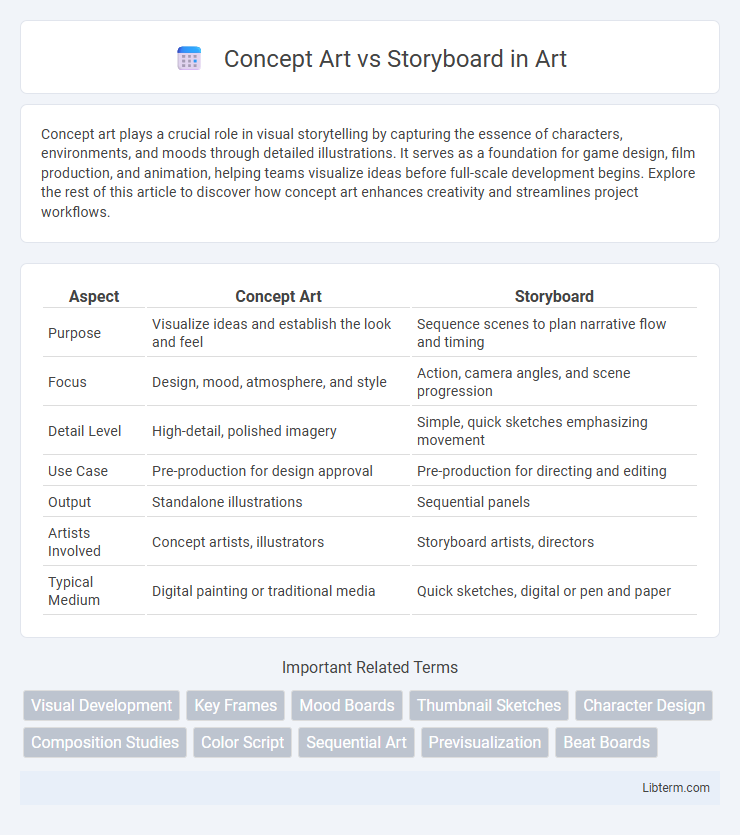Concept art plays a crucial role in visual storytelling by capturing the essence of characters, environments, and moods through detailed illustrations. It serves as a foundation for game design, film production, and animation, helping teams visualize ideas before full-scale development begins. Explore the rest of this article to discover how concept art enhances creativity and streamlines project workflows.
Table of Comparison
| Aspect | Concept Art | Storyboard |
|---|---|---|
| Purpose | Visualize ideas and establish the look and feel | Sequence scenes to plan narrative flow and timing |
| Focus | Design, mood, atmosphere, and style | Action, camera angles, and scene progression |
| Detail Level | High-detail, polished imagery | Simple, quick sketches emphasizing movement |
| Use Case | Pre-production for design approval | Pre-production for directing and editing |
| Output | Standalone illustrations | Sequential panels |
| Artists Involved | Concept artists, illustrators | Storyboard artists, directors |
| Typical Medium | Digital painting or traditional media | Quick sketches, digital or pen and paper |
Introduction to Concept Art and Storyboarding
Concept art serves as the visual foundation for creative projects, providing detailed illustrations that establish the mood, characters, and environments before production begins. Storyboarding breaks down the narrative into sequential frames, mapping out key scenes and camera angles to guide the pacing and storytelling flow. Both disciplines collaborate closely to ensure visual coherence and effective communication of the story's vision throughout development.
Defining Concept Art: Purpose and Process
Concept art serves as the visual foundation for characters, environments, and objects in creative projects, primarily used to convey design ideas before production. The process involves initial sketches, iterations, and refinements to establish style, mood, and narrative tone, guiding the overall aesthetic direction. Concept artists collaborate closely with directors and designers to ensure alignment with the project's vision and technical requirements.
What is a Storyboard? Key Functions Explained
A storyboard is a visual planning tool used in film, animation, and video production that sequences illustrations or images to represent scenes and key actions. Its key functions include mapping out the narrative flow, defining camera angles, and organizing scene transitions to ensure coherent storytelling and efficient production. Storyboards help directors, animators, and production teams visualize the script, identify potential issues early, and streamline the creative process.
Core Differences: Concept Art vs Storyboard
Concept art and storyboards serve distinct purposes in visual storytelling: concept art focuses on designing key characters, environments, and moods to establish the project's aesthetic direction, while storyboards visualize the sequence of actions and camera angles to plan the narrative flow. Concept art emphasizes the creation of detailed, standalone images that inspire the overall visual style, whereas storyboards use simplified frames to depict movement, timing, and shot composition in a chronological order. This core difference highlights concept art as a foundational visual guide and storyboards as a practical tool for pre-visualizing and organizing scenes during production.
Visual Style: Detailed Art vs Sequential Sketches
Concept art emphasizes highly detailed visuals to establish mood, color palettes, and intricate character or environment designs, serving as a reference for the overall visual style. Storyboards utilize simplified, sequential sketches to convey key actions, camera angles, and narrative flow, prioritizing clarity and timing over detailed artistry. This distinction allows concept art to inspire aesthetic direction, while storyboards focus on storytelling and scene composition efficiency.
Role in Pre-Production: Where They Fit
Concept art establishes the visual style and mood of a project by creating detailed imagery of characters, environments, and key scenes, serving as a foundational guide for the production team. Storyboards focus on sequencing and narrative flow, illustrating shot composition, camera angles, and timing to plan the visual storytelling before filming or animation begins. Both are essential in pre-production, with concept art shaping the project's aesthetic and storyboards organizing the story's progression and pacing.
Skills Required: Concept Artist vs Storyboard Artist
Concept artists require strong skills in visual storytelling, color theory, and environmental design to create detailed, immersive worlds and character concepts that convey mood and atmosphere. Storyboard artists must excel in sequential storytelling, shot composition, and timing to effectively translate scripts into dynamic frames that guide camera movement and actor performance. Both roles demand proficiency in digital tools like Photoshop and Illustrator, but concept artists focus more on creativity and texture, while storyboard artists prioritize clarity and narrative flow.
Tools and Techniques Used in Each Process
Concept art relies heavily on digital painting software such as Adobe Photoshop, Corel Painter, and Procreate, utilizing techniques like color theory, perspective drawing, and environmental design to create detailed, imaginative visuals that establish the look and feel of a project. Storyboarding employs specialized tools such as Storyboard Pro and SketchBook, focusing on sequential sketching, composition, and timing to visually map out scenes and narrate the story flow effectively. Traditional methods, like pencil and ink sketches, remain foundational in both processes, supplemented by digital enhancements for clarity and iteration speed.
Impact on Final Production: Storytelling and Visuals
Concept art establishes the visual tone and atmosphere, influencing the overall aesthetic coherence of the final production. Storyboards map out narrative pacing and shot composition, ensuring clarity and continuity in storytelling. Together, they shape the viewer's emotional engagement and the seamless execution of visual narratives.
Choosing the Right Approach for Your Project
Concept art establishes the visual tone and detailed design of characters, environments, and objects, making it ideal for projects seeking to define artistic style and mood. Storyboards focus on sequence, pacing, and narrative flow, providing a clear blueprint for visual storytelling and scene transitions. Selecting concept art benefits projects emphasizing visual development, while storyboards excel in pre-visualizing actions and directing production timelines.
Concept Art Infographic

 libterm.com
libterm.com